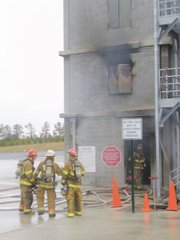It is a rainy, cloudy Friday morning and things are quiet at the fire and rescue training system, only the sound of rain hitting the tops of cars and tents. Smoke begins to billow from the windows of a house built in the middle of a large asphalt lot, and then the orange light of flames becomes visible through an open window. As the fire increases, a ladder truck races into view and pulls to a stop in front of the building, followed quickly by one fire engine, then another. As they stop, firefighters drop from the inside of the trucks and set to work, pulling down ladders, unrolling hoses and assembling their gear. Crouching before the entrance to the building, the firefighters pull on their gear and prepare to enter the fire.
Friday, Oct. 19, marked the first day recruit class 22 was able to put together skills and information they have learned in the past several weeks towards battling a live fire in the burn building at the department’s Leesburg training center.
"It’s intense and stressful," recruit James Shelton said during the class’ lunch break. "There’s a huge adrenaline rush when you go in."
BEGINNING FIRST thing in the morning, the recruits ran fire after fire, each situation presenting the firefighters with a different situation and challenge.
"We try to do the progression," Capt. James Williams, who oversees the recruit training, said. "We start with one room and move all the way to multiple-floor fire with multiple victims."
The idea, Williams said, is to expose recruits to all the different situation they may encounter out in the field. To that end, one side of the Loudoun burn building is designed inside to represent a single-family home, while the other side is built as an apartment building, complete with fire escape.
"During each run, each recruit will be assigned to a different apparatus and job," Battalion Chief Kevin Wright, who came in from the field to assist with the burn building training, said. "We put them through all the tasks prior to [going into the building] so that they know what to expect."
SINCE CONDITIONS inside the burn building are reflective of the fires recruits will see once they are assigned to a house, safety remains a top concern for Williams and his training staff.
"After every two burns, we bring them out and do a basic medical evaluation," Williams said. "It’s for our knowledge, but mostly it’s for their health."
Ceiling temperatures inside the burn building can reach up to 800 to 1,200 degrees, Wright said, with floor-level temperatures can reach between 300 and 600 degrees.
"That’s in the room where the fire actually is," Wright said. "The building has sensors for if the temperature reaches 1,500 degrees. It notifies us that it has reached that level and something might need to be done."
THERE IS A technique to everything during a fire and recruits are trained thoroughly on each one, from how to lower a ladder after a fire to the proper unrolling of a hose.
"Just about every task out there is taught extensively," Wright said. "We are under the state law. They lay out how many hours need to be spent training for each task."
During the fire, the recruits’ instructors are on hand, helping to ignite the fire and observing what the recruits are doing. Career firefighters are also brought in from the field to work with the recruits in smaller groups.
"We let [the recruits] do everything without instruction inside, with the exception of if there is something that is a safety issue," Williams said. "Each instructor will do a critique of their group after each run and at the end of the day we’ll do a group evaluation."
THE RECRUITS said entering the building for the first time was something many of them could not truly prepare for.
"The visibility is truly nothing," Robert Topa, a volunteer firefighter from Springfield, said.
"When you are crawling, you can’t see anything," Shelton said. "You’re running into walls and each other. You really get to know your limits in there."
The training the recruits received, however, helped them to manage the situation and complete the tasks they were assigned.
"They train it so much into you that it becomes second nature," Katie Wenner, the class’s only female recruit, said. "You get to know yourself a lot better."
Topa said that while everyone is trained in each skill, being assigned a specific task for each fire helps the process to run more smoothly and allows the recruits to work together easily.
"We know how to prioritize and do it all more efficiently," he said. "It takes a lot of practice, but we tend to learn quickly."

